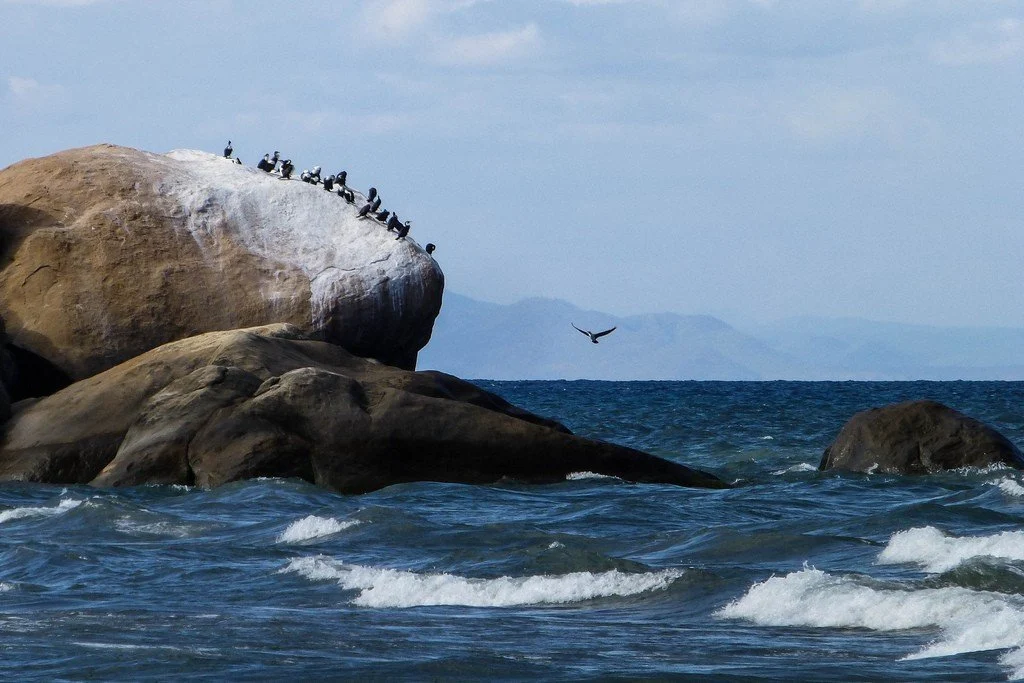Lake Malawi in Lake Malawi National Park is the third largest lake in Africa and the ninth largest in the world. The length of the lake is 560 km, width - 80 km, depth - 700 m.
 |
| Lake Malawi National Park |
General Information
In the waters of Malawi, there is the largest variety of tropical fish among the freshwater lakes of the world, according to various estimates, from 500 to 1000 species of fish live in it. Eleven families are represented in the lake, but one of them - cichlids - covers 90% of lake fish species, most of which are endemic. Cichlids occupy most of the ecological niches of the lake. Lake cichlids are divided into two large groups: pelagic, predominantly predatory species that live in the water column away from the coast, and coastal ones, among which there is a rich variety of shapes, sizes, feeding methods and behavior. Although the species diversity of pelagic cichlids is also high by any standards, it is in coastal societies that it reaches its absolute maximum. Near the rocky shores of the lake, on a plot of 50 m², you can count up to 500 fish of various species. There are species and varieties that are endemic to certain parts of the lake or even to certain bays or sections of the coast. Cichlids are the base of the lake fishery and provide food for a significant part of the population of Malawi, some species are presented as ornamental aquarium fish that are sold abroad.
 |
| Lake Malawi National Park |
In addition to fish, the lake ecosystem is characterized by a large number of crocodiles, as well as African whooper eagles that prey on fish. Every year there is a mass flight of lake flies, the larvae of which live at the bottom in the shallow parts of the lake; clouds of flies these days overshadow the sun and close the horizon.
The honor of discovering Lake Malawi is attributed to Dr. David Livingston, although, of course, he was not the first European to see this magnificence. Livingston called Lake Malawi the Lake of Stars for its sparkling surface.
This area of stunning beauty, belonging to the western part of the Rift Valley, spans several islands, the Nan Kumba Peninsula and Cape Maclear. Wooded hills and rocky cliffs rising sharply from clear blue waters are reflected in the clear clear water of the lake.
 |
| Lake Malawi National Park |
There are no settlements within the boundaries of the park, but the shore of the lake is densely populated. The locals depend on fishing, as the infertile soil makes agriculture unprofitable here.
Among the various zones in the area are wooded hills, swamps, reed lagoons inhabited by hippos, leopards, chakma (bear baboons), green monkeys, bush pigs, elephants occasionally appear. The islands in the lake, especially Mumbo and Boad Zulu, are important nesting sites for several thousand white-breasted cormorants. Of the reptiles, crocodiles live here, as well as many monitor lizards.
The lake is shared by three countries: Malawi, Mozambique and Tanzania. In the north of the lake, there is a dispute over the distribution of its waters between Malawi and Tanzania. Tanzania believes that the border should run along the surface of the lake, following the lines that existed between the former German East Africa and Nyasaland until 1914. Malawi claims that it should own the entire lake up to the very Tanzanian shore, on the grounds that this is how the administrative border between the British Nyasaland and the Tanganyika mandate ran after the First World War: the Tanzanian coasts were sparsely populated, and the British considered it inconvenient to arrange a separate administration for the north. -eastern sector of the lake. This conflict has led to clashes in the past, but since then, for many decades, Malawi has not tried to restore its claims.
 |
| Lake Malawi National Park |
Most of the lake and its basin (68%) is within Malawi; the western border of the country practically coincides with the western watershed. 25% of the basin is occupied by Tanzania, 7% by Mozambique. The Tanzanian sector of the basin is disproportionately important for the hydrological balance of the lake, since the bulk of precipitation falls here, only from the Ruhuhu River in Tanzania the lake receives more than 20% of the annual inflow of water.
The islands of Likoma and Chisumulu are located in the eastern part of the lake inside the Mozambican sector off the coast, but belong to Malawi, forming two Malawian exclaves surrounded on all sides by Mozambican territorial waters.